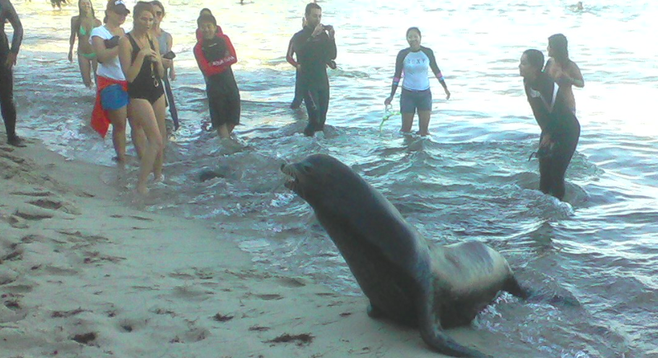 Facebook
Facebook
 X
X
 Instagram
Instagram
 TikTok
TikTok
 Youtube
Youtube

A California appellate court ruled yesterday (February 9) that the City of San Diego is not responsible for the mitigation of the foul odors wafting from the seal lions at La Jolla Cove.
The ruling quashes a lawsuit filed by a group of residents, known as Citizens for Odor Nuisance Abatement. The group's 2013 lawsuit asserted that the odors from sea lion and bird feces created a public nuisance for residents, visitors, and businesses around La Jolla Cove.
The group claimed the odors impacted tourism and reduced nearby property values. They blamed the stench on the city's decision to construct fences on the bluffs for the purpose of restricting human access allowed sea lion and cormorant populations to grow. Experts hired by the group testified that the city could reduce the stench by trying to modify the behavior of the sea lions as well as hiring crews to "scoop the poop."
Months before the 2013 lawsuit was filed, then-mayor Bob Filner hired an outside vendor to apply a microbial cleaner to the guano-stained rocks and nearby bluffs. While successful in lessening the odor from bird feces, the odors from sea-lion excrement and cormorant feces remained.
The city argued that it was not responsible for having to control wild animal populations and questioned whether the fences was the sole reason for the growth in sea-lion populations. Superior Court judge Timothy Taylor sided with the city in 2013, finding that the city not responsible for having to control nuisances caused by wild animals; that the spike in sea lion population is likely attributable to the favorable conditions for the animals, and was not a result of any nearby fencing.
Attorneys for the Citizens for Odor Nuisance Abatement appealed the decision to no avail.
"In short, causation is an essential element of a public nuisance action," reads the February 9 appellate court decision. "That sea lions and cormorants are wild animals is not dispositive of the city's liability. The city could be held liable for the alleged odor nuisance if [Citizens for Odor Nuisance Abatement] were to demonstrate the city's conduct was a substantial factor in causing the alleged harm."
The appellate court considered the group's argument to be a "logical fallacy" by placing all the blame on the presence of the fences: "after the fence, therefore, because of the fence,” the judges wrote does not set forth a "causal nexus."
"We sympathize with [Citizens for Odor Nuisance Abatement] but agree with the trial court that any resolution likely lies in the political sphere...courts are comparatively ill situated to solve this type of problem."


A California appellate court ruled yesterday (February 9) that the City of San Diego is not responsible for the mitigation of the foul odors wafting from the seal lions at La Jolla Cove.
The ruling quashes a lawsuit filed by a group of residents, known as Citizens for Odor Nuisance Abatement. The group's 2013 lawsuit asserted that the odors from sea lion and bird feces created a public nuisance for residents, visitors, and businesses around La Jolla Cove.
The group claimed the odors impacted tourism and reduced nearby property values. They blamed the stench on the city's decision to construct fences on the bluffs for the purpose of restricting human access allowed sea lion and cormorant populations to grow. Experts hired by the group testified that the city could reduce the stench by trying to modify the behavior of the sea lions as well as hiring crews to "scoop the poop."
Months before the 2013 lawsuit was filed, then-mayor Bob Filner hired an outside vendor to apply a microbial cleaner to the guano-stained rocks and nearby bluffs. While successful in lessening the odor from bird feces, the odors from sea-lion excrement and cormorant feces remained.
The city argued that it was not responsible for having to control wild animal populations and questioned whether the fences was the sole reason for the growth in sea-lion populations. Superior Court judge Timothy Taylor sided with the city in 2013, finding that the city not responsible for having to control nuisances caused by wild animals; that the spike in sea lion population is likely attributable to the favorable conditions for the animals, and was not a result of any nearby fencing.
Attorneys for the Citizens for Odor Nuisance Abatement appealed the decision to no avail.
"In short, causation is an essential element of a public nuisance action," reads the February 9 appellate court decision. "That sea lions and cormorants are wild animals is not dispositive of the city's liability. The city could be held liable for the alleged odor nuisance if [Citizens for Odor Nuisance Abatement] were to demonstrate the city's conduct was a substantial factor in causing the alleged harm."
The appellate court considered the group's argument to be a "logical fallacy" by placing all the blame on the presence of the fences: "after the fence, therefore, because of the fence,” the judges wrote does not set forth a "causal nexus."
"We sympathize with [Citizens for Odor Nuisance Abatement] but agree with the trial court that any resolution likely lies in the political sphere...courts are comparatively ill situated to solve this type of problem."
Comments